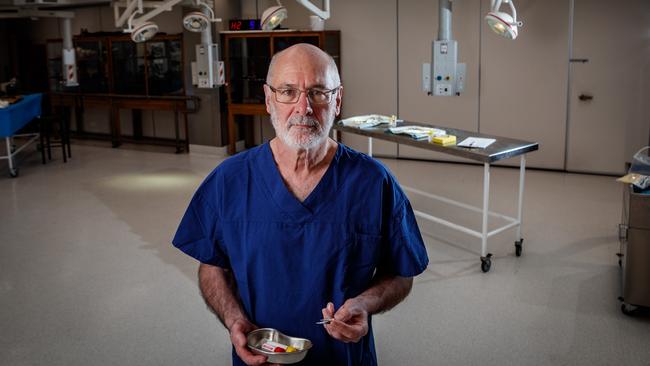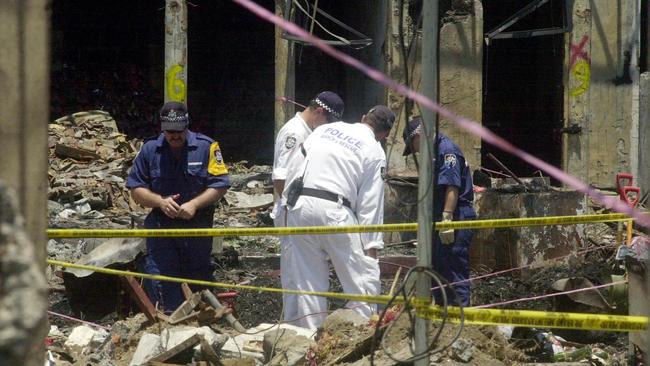Guardians of the Dead podcast Episode 2: ‘There were just so many dead people’ | Bali bombings, Boxing Day tsunami
Prof Roger Byard is used to dealing with death. But what he saw after the Bali bombings and Thai tsunami was on a different scale. One he wasn’t quite prepared for. Listen to episode 2.
True Crime
Don't miss out on the headlines from True Crime. Followed categories will be added to My News.
WARNING: This podcast series features graphic descriptions of forensic pathology techniques, and descriptions of violent crimes, accidentsand traumatic incidents that some listeners may find distressing or upsetting.
One was an act of pure evil, the other a natural disaster, but the 2002 Bali bombings and 2004 Thailand tsunami shared one chilling feature; the terrifying speed with which both of them extinguished so many innocent lives.
In the weeks after the tragedies, Prof Roger Byard’s job was not to move quickly, but to go slowly. To thoroughly and carefully carry out the work of helping identify the victims, so that, at the very least, the tens of thousands of grieving families could have a shred of certainty after all the chaos and confusion - could take something back from events that had taken everything.
“The last thing you want to do is come in and speed the process,” Prof Byard says in the latest episode of Guardians of the Dead, a podcast from The Advertiser, True Crime Australia and the University of Adelaide.
“Some of the local bodies in Indonesia were released on visual identification and we know that that’s not good. Some of the bodies, I believe, were released in the early days based on jewellery and you know, the jewellery you get in Kuta is available to everybody.
LISTEN: GUARDIANS OF THE DEAD - EPISODE 2: BALI BOMBINGS, BOXING DAY TSUNAMI
“So it can be heartbreaking because you may have identified a body, but you have to follow the process, even though you know the family want that person back.”
Two-hundred and four people, including 88 Australians, were killed in Bali when members of the terrorist organisation Jemaah Islamiah detonated two bombs at nightclubs in the popular tourist district of Kuta on October 12, 2002.
On Boxing Day in 2004, an earthquake in the Indian Ocean triggered a massive tsunami that smashed into 13 Asian countries, leaving a trail of destruction and killing 230,000 people.
Prof Byard says both disasters were incredibly confronting and challenging in their own way.
“I was there (in Bali) a month or two after it had happened and of course the facilities were not good. And the preservation of the bodies was not good, the bodies had been fragmented and burnt.

“What happened at the Sari Club when they set the first bomb off was that the bomb was in a vehicle in the street and it blew through the wrought iron and glass at the front of the club so what you get is secondary projectiles.
“So it’s not only the explosion and the material out of the bomb, it’s this glass and metal that’s going in as well.
“Then you get people panicking and trying to escape and piling up, you get crush asphyxias, the fire was there so there’s burns and carbon monoxide toxicity.
“So it’s a really quite complicated scenario, and essentially you’re also looking for bits of the bomb. And this is one of the problems in terrorist actions is has all the explosive material been detonated? Or is there stuff hidden in bodies? That can be quite dangerous, obviously.”
In order to thwart possible follow up terror attacks, recovery crews were driven to work each day via different routes. But in the moment, Prof Byard says, he wasn’t afraid.

“I think when you’re naive you don’t get afraid,” he says, adding that he didn’t arrive in Bali until several weeks after the tragedy.
“But I remember a colleague saying he was there in the first two weeks and a motorbike backfired outside the mortuary and everybody went under tables and they locked down the place, because you just don’t know.
“And the thing with Bali, ok, you’ve had this incredible explosion. What’s happened? Is it an underground gas leak? If it is a terrorist attack, are they going to come up over the hill with machine guns?
“And of course in Bali we had the explosion at the Sari Club and then a little while later the suicide bomber at Paddy’s Bar, so there were two events very close. Could there be three? Sure there could.”
There were no such security fears in Thailand. His overriding memories are sensory.
“The first day I arrived you could smell where we were going about three or four kilometres down the road. And I’m wandering around with my assistant and we’re just looking at these bodies and then a truck pulled up and just dumped, I don’t know, 50 to 100 bodies, in a pile to be processed. And of course it’s in the tropics, so it’s hot.

“It was a tsunami so basically it washed everything into pools. And the sewers were open, dead bodies, there’s metal, tin, cars, it’s really quite a dangerous environment. And very stressful and hard work, really.”
“The Thais very generously worked outside so that the Europeans could work inside. But inside came with its problems. I mean we were in a temple, because they would bring the bodies to the temples. It had no running water. It was really hot and we couldn’t clean the floors, so the floors were so slippery.”
Despite the testing conditions, Prof Byard and his team worked methodically, day after day, to identify victim after victim after victim.
“We were doing just truncated internal examinations. We were just opening the abdomen, what we’re looking for is any signs of surgery and we’re looking for uterus, something to show it was a female or whether it was a male.

“Sometimes we’d be looking for artificial hips, that sort of thing. Tattoos, important. Jewellery. Europeans often have their names on the inside of their wedding rings and there were a lot of married couples in Thailand because it was a family event.”
Prof Byard says he must have examined “hundreds” of bodies during his two weeks in Thailand and, of course, was shocked by the scale of the disaster.
“But it was also things like seeing photographs of... a wedding photograph of a young couple in the sand, you know, clearly one of them had had it in their belongings and it had just been washed away. Maybe they were on their honeymoon? That sticks with you.”
But despite the pall of death, Prof Byard also recalls real moments of beauty.
“When you arrive at the temple, which is where the Thais bring the bodies, the temple environment is extraordinary. The monks were just amazing. They would wander around at night chanting, helping the spirits go to wherever they were going to go. Didn’t matter whether you were a Catholic or a hedonist, they were going to help you do that. And I thought that was a wonderful way to look after the people. And I think it must have been a lot of comfort for the people at home to know that these people were actually there caring.
“They had a ceremony to honour the dead and they put up 2000 rice paper lanterns that went up into the sky. They’d actually diverted planes around and it was like the Milky Way was just overhead. It was the most beautiful thing I’ve ever seen. You could sort of almost touch them. And then the next day we were back getting truckloads of bodies.”
As with Bali Prof Byard says he didn’t stop to think about the enormity of what he was being asked to deal with - at least not in the moment.
“It’s when you get home and you’re sitting in your house, on your own and you’re thinking ‘what in the name of god have I just seen?’ And that’s why I didn’t want to go back, I just found it, it was one of the most confronting periods, I think, in my career.
“I thought I’d seen everything, but clearly not.”



